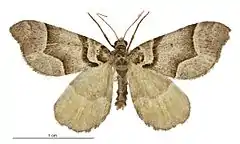Helastia siris
Helastia siris is a moth of the family Geometridae. This species is endemic to New Zealand. It is classified as "At Risk, Relict'" by the Department of Conservation.
| Helastia siris | |
|---|---|
 | |
| Male | |
| Scientific classification | |
| Kingdom: | |
| Phylum: | |
| Subphylum: | |
| Class: | |
| Order: | |
| Family: | |
| Genus: | |
| Species: | H. siris |
| Binomial name | |
| Helastia siris (Hawthorne, 1897)[1] | |
| Synonyms[2] | |
| |
Taxonomy
This species was first described by E. F. Hawthorne in 1897 using a specimen he collected in Wellington and named Asaphodes siris.[3][2] George Hudson discussed and illustrated this species in his 1898 book under the same name and in his 1928 book as synonym of Hydriomena triphragma.[4][5] In 1987 Robin C. Craw placed this species within the genus Helastia.[6] The holotype specimen is held at the Museum of New Zealand Te Papa Tongarewa.[2]
Description
Hudson described the species as follows:
The expansion of the wings is about 7⁄8 inch. The fore-wings are dull ochreous ; there is a small curved brown patch near the base ; then a pale band, followed by a very broad brown central band, paler in the middle ; there is a very sharp projection on the outer edge of the central band, a conspicuous black dot in the centre of the wing, and a series of minute black dots on the termen. The hind-wings are pale ochreous, with a faint central transverse line.[4]
Distribution
This species is endemic to New Zealand.[7][1] It occurs in Wellington, Stephens Island and in the Chatham Islands.[6] It has been collected from Baring Head.[8]
Biology and lifecycle
Very little is known about the biology of H. siris.[9] It is on the wing in March.[4]
Host species and habitat
This species prefers short tussock grassland habitat in coastal areas.[6] The host species for the larvae of H. siris is unknown.[9] It has been hypothesised the larvae of H. siris feed on the flowers of Helichrysum species and then feed on mosses, lichens or shrubs growing nearby.[10]
Conservation status
This moth is classified under the New Zealand Threat Classification system as being "At Risk, Relict".[11]
References
- "Helastia siris (Hawthorne, 1897)". www.nzor.org.nz. Landcare Research New Zealand Ltd. Retrieved 2018-05-16.
- Dugdale, J. S. (1988). "Lepidoptera - annotated catalogue, and keys to family-group taxa" (PDF). Fauna of New Zealand. 14: 181. Retrieved 16 May 2018.
- Hawthorne, E. F. (1897). "Descriptions of two new species of Lepidoptera". Transactions and Proceedings of the New Zealand Institute. 29: 282–283 – via Biodiversity Heritage Library.
- Hudson, G. V. (1898). New Zealand moths and butterflies (Macro-lepidoptera). London: West, Newman & Co. p. 55. OCLC 10581623.
- Hudson, G. V. (1928). The Butterflies and Moths of New Zealand. Wellington: Ferguson & Osborn Ltd. p. 98. OCLC 25449322.
- Craw, R. C. (1987). "Revision of the genus Helastia sensu stricto with description of a new genus (Lepidoptera: Geometridae: Larentiinae)". New Zealand Journal of Zoology. 14 (2): 269–293. doi:10.1080/03014223.1987.10422997.
- Gordon, Dennis P., ed. (2010). New Zealand inventory of biodiversity. Volume two. Kingdom animalia : chaetognatha, ecdysozoa, ichnofossils. Vol. 2. Christchurch, N.Z.: Canterbury University Press. p. 459. ISBN 9781877257933. OCLC 973607714.
- Crisp, Philippa (2008). "Baring Head ecological values" (PDF). www.gw.govt.nz. Retrieved 16 May 2018.
- Patrick, Brian; Dugdale, John S. (2000). Conservation status of the New Zealand lepidoptera (PDF). Wellington, N.Z.: Department of Conservation, New Zealand. p. 24. ISBN 978-0478218671. OCLC 154670803.
- Patrick, Brian (2014). "Of lichens and mosses" (PDF). Butterflies and Moths of New Zealand. 11: 8.
- Hoare, R.J.B.; Dugdale, J.S.; Edwards, E.D.; Gibbs, G.W.; Patrick, B.H.; Hitchmough, R.A.; Rolfe, J.R. (2017). Conservation status of New Zealand butterflies and moths (Lepidoptera), 2015 (PDF). Wellington, New Zealand: New Zealand Department of Conservation. p. 8. ISBN 9781988514383.
External links
| Wikimedia Commons has media related to Helastia siris. |
| Wikispecies has information related to Helastia siris. |